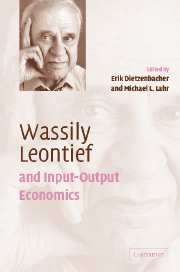Book contents
- Frontmatter
- Contents
- List of contributors
- List of figures
- List of tables
- Preface
- Part I Reflections on input-output economics
- Part II Perspectives of input-output economics
- 10 A neoclassical analysis of total factor productivity using input-output prices
- 11 What has happened to the Leontief Paradox?
- 12 The decline in labor compensation's share of GDP: a structural decomposition analysis for the United States, 1982 to 1997
- 13 An oligopoly model in a Leontief framework
- 14 Economies of plant scale and structural change
- 15 Technological change and accumulated capital: a dynamic decomposition of Japan's growth
- 16 Japan's economic growth and policy-making in the context of input-output models
- 17 Contributions of input-output analysis to the understanding of technological change: the information sector in the United States
- 18 How much can investment change trade patterns? An application of dynamic input-output models linked by international trade to an Italian policy question
- 19 Social cost in the Leontief environmental model: rules and limits to policy
- Subject index
- Author index
17 - Contributions of input-output analysis to the understanding of technological change: the information sector in the United States
Published online by Cambridge University Press: 22 September 2009
- Frontmatter
- Contents
- List of contributors
- List of figures
- List of tables
- Preface
- Part I Reflections on input-output economics
- Part II Perspectives of input-output economics
- 10 A neoclassical analysis of total factor productivity using input-output prices
- 11 What has happened to the Leontief Paradox?
- 12 The decline in labor compensation's share of GDP: a structural decomposition analysis for the United States, 1982 to 1997
- 13 An oligopoly model in a Leontief framework
- 14 Economies of plant scale and structural change
- 15 Technological change and accumulated capital: a dynamic decomposition of Japan's growth
- 16 Japan's economic growth and policy-making in the context of input-output models
- 17 Contributions of input-output analysis to the understanding of technological change: the information sector in the United States
- 18 How much can investment change trade patterns? An application of dynamic input-output models linked by international trade to an Italian policy question
- 19 Social cost in the Leontief environmental model: rules and limits to policy
- Subject index
- Author index
Summary
By means of reckoning appropriate to such interdependence [as that of input-output analysis], the quantification can do much to clarify otherwise elusive structural relations. These relations, moreover, may be consequential for one or another practical purpose.
(Bergson, 2000)Methodological issues
The outcome of years of technical change within the economy of the United States is impressive, and of great importance in interpreting the economic performance of the 1990s (and before) and the early twentyfirst century. Macrodynamic statistics are both indicative and provocative, but they do not tell the story of what has been going on within the economy. The purpose of the present paper is to investigate some of the internal workings of information technology (IT) through the eyes of the input-output accounts for 1972 to 1996.
Semi-annually, the Bureau of Labor Statistics publishes International Comparisons of Manufacturing Productivity and Unit Labor Cost Trends. In its release of October 17, 2000, it reports the percentage change in manufacturing output per hour during 1999. The bar for the United States in figure 17.1, covering comparable data for ten major industrial countries, shows a towering figure of 6.2% growth for 1999, far above the other bars.
It has not always been so, but in many respects the performance of the US economy in the 1990s has been excellent in producing record non-infiationary output expansion, and much of this success rests upon the productivity performance of the economy.
- Type
- Chapter
- Information
- Wassily Leontief and Input-Output Economics , pp. 311 - 336Publisher: Cambridge University PressPrint publication year: 2004

